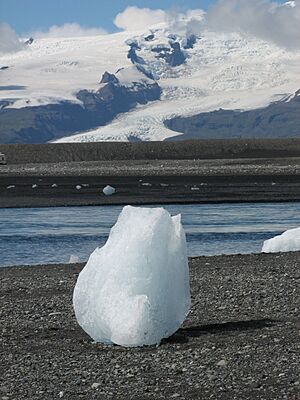Vatnajökull facts for kids
Quick facts for kids Vatnajökull |
|
|---|---|
| Vatna Glacier | |

Vatnajökull, Iceland
|
|
| Type | Ice cap |
| Location | Iceland |
| Coordinates | 64°24′N 16°48′W / 64.400°N 16.800°W |
| Area | 7,900 km2 (3,100 sq mi) |
| Thickness | 380 m (1,250 ft) average |
| Terminus | Outlet glaciers |
| Status | Retreating |
Vatnajökull is the biggest ice cap in Iceland. It is also the second largest in all of Europe. This huge glacier covers about 10% of Iceland's land, located in the southeast part of the country. Its name means "Glacier of Lakes" in Icelandic.
Contents
How Big is Vatnajökull?
Vatnajökull covers an area of 7,900 square kilometers. This makes it the second largest ice cap in Europe. Only the Severny Island ice cap in Russia is bigger.
The ice on Vatnajökull is very thick. On average, it is 380 meters (about 1,247 feet) deep. In some places, it can be as thick as 950 meters (about 3,117 feet)!
Iceland's highest mountain, Hvannadalshnúkur, is found on the southern edge of Vatnajökull. This peak is 2,109.6 meters (6,921 feet) tall. On June 7, 2008, Vatnajökull became part of the Vatnajökull National Park.
Volcanoes Under the Ice
Many glaciers in Iceland, including Vatnajökull, hide active volcanoes underneath them. When these volcanoes erupt, they can melt large amounts of ice. This melting creates huge pockets of water under the glacier.
Sometimes, this water can burst out from under the ice. This event is called a jökulhlaup, or a glacial lake outburst flood. It's like a giant flood caused by a glacier.
During the last ice age, many volcanic eruptions happened under Vatnajökull. These eruptions formed special types of volcanoes that grew under the ice.
Even today, volcanoes under Vatnajökull still erupt. This has caused many floods throughout history. For example, in 1934, a jökulhlaup released 15 cubic kilometers of water over several days.
In 1996, a large jökulhlaup came from the volcanic lake Grímsvötn, which is under the glacier. Another eruption happened in Grímsvötn in November 2004. More recently, on May 21, 2011, Grímsvötn erupted again. The ash cloud from this eruption reached up to 17 kilometers (about 10.5 miles) high!
Vatnajökull in Pop Culture
Vatnajökull has appeared in many movies and TV shows.
- In 1985, the glacier was used for the opening scene of the James Bond film A View to a Kill.
- Other movies have filmed at Jökulsárlón, a lake where icebergs break off Vatnajökull.
- In 2004, the TV show The Amazing Race 6 visited Vatnajökull.
- The music video for Westlife's song "What About Now" was filmed on the glacier in 2009.
- In November 2011, Vatnajökull was a filming location for the second season of the HBO fantasy TV series Game of Thrones.
An older Icelandic name for Vatnajökull was Klofajökull.
In September 1950, a plane from the airline Loftleiðir crash-landed on Vatnajökull. All six people on board survived. They sent a distress signal and were rescued after walking 34 kilometers to safety.
Glaciers Flowing from Vatnajökull
Vatnajökull has about 30 smaller glaciers that flow out from its main ice cap. These are called "outlet glaciers." In Icelandic, the word for glacier is "jökull."
Here are some of the outlet glaciers from Vatnajökull:
Southern territory
- Breiðamerkurjökull
- Brókarjökull
- Falljökull
- Fjallsjökull
- Fláajökull
- Heinabergsjökull
- Hoffellsjökull
- Hólárjökull
- Hrútárjökull
- Kvíárjökull
- Lambatungnajökull
- Morsárjökull
- Skaftafellsjökull
- Skálafellsjökull
- Skeiðarárjökull
- Stigárjökull
- Svínafellsjökull
- Viðborðsjökull
- Virkisjökull
Eastern territory
- Brúarjökull
- Eyjabakkajökull
- Kverkjökull
Northern territory
- Dyngjujökull
Western territory
- Köldukvíslarjökull
- Síðujökull
- Skaftárjökull
- Sylgjujökull
- Tungnaárjökul
See also
- Geography of Iceland
- Iceland plume
- Vatnajökull National Park
 In Spanish: Vatnajökull para niños
In Spanish: Vatnajökull para niños






